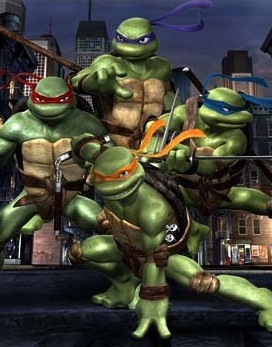Friday, March 30, 1990
TEENAGE MUTANT NINJA TURTLES. Written by Todd W. Langen and Bobby Herbeck, based on the comic book characters created by Kevin Eastman and Peter Laird. Music by John Du Prez. Directed by Steve Barron. Running time: 87 minutes. Mature entertainment with the B.C. Classifier's warning: some violence.
LET ME SEE IF I've got this straight.
Michelangelo does impressions. His Stallone is a little shaky, but his Cagney is right on.
Donatello is the mechanic. We see him working on cars.
Leonardo is the soulful, caring one, while Raphael is the loner, the one who takes solitary nocturnal walks.
But, darn it, they all look alike!
Not so, says my 13-year-old, scornful at my limited store of practical lore. She knows that the Teenage Mutant Ninja Turtles are colour coded and weapons specific.
Mike, the nunchaku master, wears an orange headband-mask, while Leo, in the blue mask, is a swordsman.
Red-masked Raph is armed with a pair of sai, those Asian fighting knives that look like little pitchforks. Don, whose colour is purple, beats on the baddies with a simple wooden staff.
I blame director Steve Barron. Though a whizzbang action-fantasy filmmaker, he never makes it clear just who is who.
He gets almost everything else right, though. The man who made us care about a lovelorn computer (in 1984's Electric Dreams), Barron manages to establish a fine silly-seriousness in this cartoon-inspired superhero spoof.
To his credit, he understands that the Todd W. Langen/Bobby Herbeck screenplay is derived from a comic book in which the emphasis is on the comic. Designed as a parody of superhero conventions, the original self-published magazine summed it all up in its title.
Typically, comic book superheroes are adolescents who, having been unexpectedly endowed with extraordinary powers, dedicate themselves to a lifelong battle with evil, circumstances that require them to adopt outlandish costumes and withdraw into themselves.
Hey, Dad, lighten up. It's called Teenage Mutant Ninja Turtles. It's supposed to be funny.
And it is. Though (I'm told) the feature film's origin story differs from the TV cartoon version, it does set up the conflict between the sewer-dwelling, man-sized turtles and a criminal organization known as The Foot.
Led by a metal-masked, Darth Vader-like villain called The Shredder, Foot has its own teenaged ninjas — runaway boys responsible for a "silent'' crime wave in New York City.
When TV news reporter April O'Neil (Judith Hoag) gets close to the truth, Foot's soldiers come after her. When TMNT come to her rescue, the battle is joined.
Presented as a live-action feature — "Hey, dude,'' say the ads, "this is no cartoon!'' — Barron's picture relies on a combination of Jim Henson constructions, costumed actors and voice performers to bring his "heroes on the half shell'' to life on the screen.
A likeable lot of reptilian youth, the Turtle brothers are quick-quipping and right-thinking, the result of a prober upbringing. Their spiritual "father'' is Splinter, an elder mutant ninja rodent.
Though their individual personalities are never fully established, as a group they're irresistible. Teenage Mutant Ninja Turtles is a film full of cartoon-style combat mitigated by rapid fire gags.
The above is a restored version of a Province review by Michael Walsh originally published in 1990. For additional information on this archived material, please visit my FAQ.
Afterword: The joke was still reasonably fresh in 1990. Six years earlier, a pair of East Coast comic artists decided to heckle the absurdities of corporate superheroes Daredevil, New Mutants (two Marvel titles), Ronin (from D.C.) and the independent Canadian comic Cerebus (created by Dave Sim). Kevin Eastman and Peter Laird self-published their first issue of Teenage Mutant Ninja Turtles in 1984. The joke caught on, and TMNT went mainstream. Comics were published. Raph and the rest became available as action figures. Their story was adapted for a 10-season TV cartoon series (1987-1996), and was played out as a 1989 video game. The 1990 live-action feature was successful enough to spin off two sequels — Teenage Mutant Ninja Turtles II: The Secret of the Ooze (1991) and Teenage Mutant Ninja Turtles III: The Turtles Are Back . . . In Time (1993). A second animated TV series ran for seven seasons (2003-2009), followed by a third, computer-animated version that began in 2012 (and was recently renewed for a fourth season on one of the kid-oriented U.S. cable networks). Putting it another way, TMNT evolved from in-joke to franchise brand in remarkably short order. The CGI-rich remake, begin released today (August 8), seems to be more a product than a work of comic-book art.
